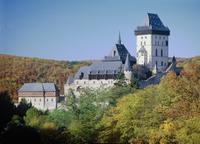
Karlštejn is the most remarkable Czech castle and is one of the symbols of the Czech Kingdom. Charles IV, the Czech King and the Roman Emperor founded the castle in 1348 on three floor levels. On the lowest floor there were situated secular residential rooms housed by the emperor, his wife and his company. On the second floor the Church of Our Lady was built and together with it the private chapel of Charles IV connected with the church by a narrow corridor. The chapel was devoted to St. Kateøina, his patroness. The second floor symbolized the place of catharsis. The highest place was the prismatic tower with the biggest sacral space of the castle – the Chapel of the Holy Rood, symbolizing “Heavenly Jerusalem”. The castle should have been originally the place of relaxation of its founder, but during more than seven years of its construction, the idea of the function gradually changed. Finally the crown jewels and relics of the crucifixion were housed here. In the period of the Charles ´s reign the castle was predominately a representative seat. From the castle it took one day to reach Prague by horse, where European political elite was meeting.
 |
In the course of the Hussite wars Karlštejn became several times the target of the attacking Hussites. In 1422 its fortifications proved its quality during the vain besiege of the Praguers. In the late 15th century there were some Late Gothic adjustments; the Great Tower rebuilding changed the silhouette of the castle. In the Rudolphinian period in 1578 – 1597 extent reconstruction in the Renaissance style were realized. In 1625 Emperor Ferdinand II abolished the status of Karlštejn and changed the castle and its dominion into the dowry of Czech queens. Maria Theresa donated the dominion to the Institute of noble women. Only in the late 18th century the historic meaning of Karlštejn was appreciated duly. The purist Regothization of the castle was decided and initiated in 1887 under the guidance of architect Josef Mocker. Some of the castle buildings were put down, some newly built. In 1910 the castle obtained the recent appearance and was opened to the public.
The prismatic Great Tower with the Chapel of the Holy Rood, consecrated in 1357 and the most expensive part of the complex, dominates the castle. The vaults are decorated by semi-precious stones, set in the shapes of crosses, and the unique collection of ideal portraits of saints, saint popes and bishops, saint rulers and spiritual teachers. Above the altar there is a niche closed by golden bars, where the crown jewels and relics were placed. The vault shows sky with the stars, the moon and the sun and the five planets, which were known at that time.
The Chapel of the Holy Rood is open – it is necessary to order the visit ahead.